Mardi Gras Decoration
What Is the Difference Between Pancake Day and Shrove Tuesday?
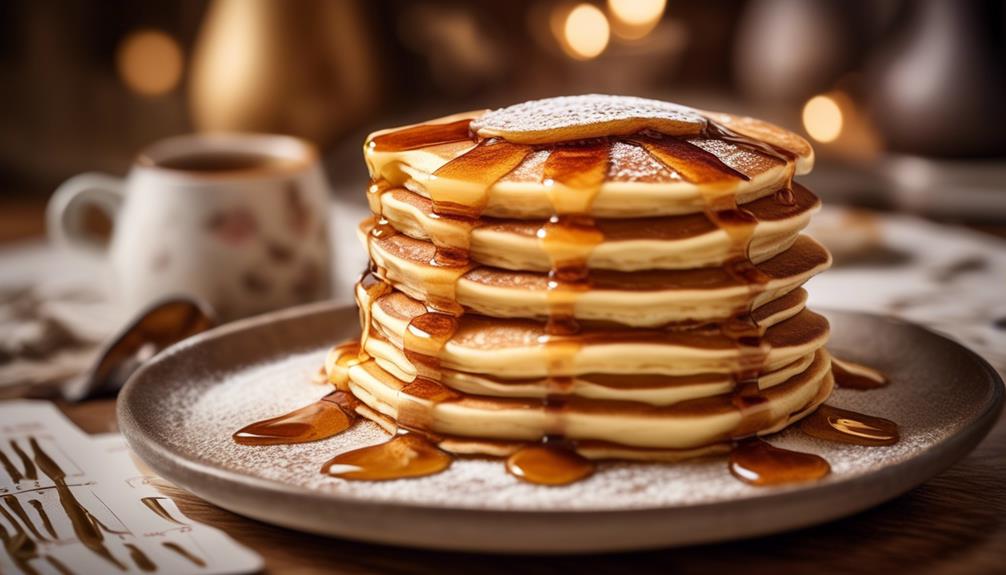
Everyone is familiar with Pancake Day and Shrove Tuesday, but were you aware that they’re actually the same celebration observed in various regions worldwide? What sets them apart are the distinct names and customs linked to each.
Understanding the origins and customs of both Pancake Day and Shrove Tuesday provides insight into the rich tapestry of cultural practices and historical significance. So, let's explore the fascinating world of these two seemingly distinct celebrations and uncover the unique nuances that set them apart.
Key Takeaways
- Pancake Day and Shrove Tuesday originated from the Christian tradition of using up rich foods before the fasting period of Lent begins.
- The purpose of Pancake Day and Shrove Tuesday is to consume ingredients like eggs, milk, and sugar, which are traditionally restricted during Lent.
- Both Pancake Day and Shrove Tuesday emphasize the importance of preparing oneself spiritually and serving others before Lent.
- Pancake Day is celebrated around the world with unique pancake recipes, traditions, and festivities, showcasing the diversity of cultures and their shared love for pancakes.
Origins of Pancake Day
Pancake Day, also known as Shrove Tuesday, has its origins in the Christian tradition of using up rich foods before the fasting period of Lent begins. This day falls on the Tuesday before Ash Wednesday, which marks the beginning of Lent. The idea behind Pancake Day was to consume ingredients like eggs, milk, and sugar, which were traditionally restricted during the Lenten fast.
The evolution of traditions surrounding Pancake Day has been fascinating. What started as a practical means to use up rich ingredients has transformed into a day of celebration and community. Families and friends come together to prepare and enjoy delicious pancakes, often in the form of fun pancake-flipping contests. Some communities also organize pancake races, adding a playful element to the day's festivities.
These activities not only commemorate the historical significance of the day but also provide a wonderful opportunity for people to come together, serve one another, and spread joy. Understanding the origins and evolution of Pancake Day helps us appreciate its deeper meaning and encourages us to continue the tradition of coming together in the spirit of service and celebration.
History of Shrove Tuesday
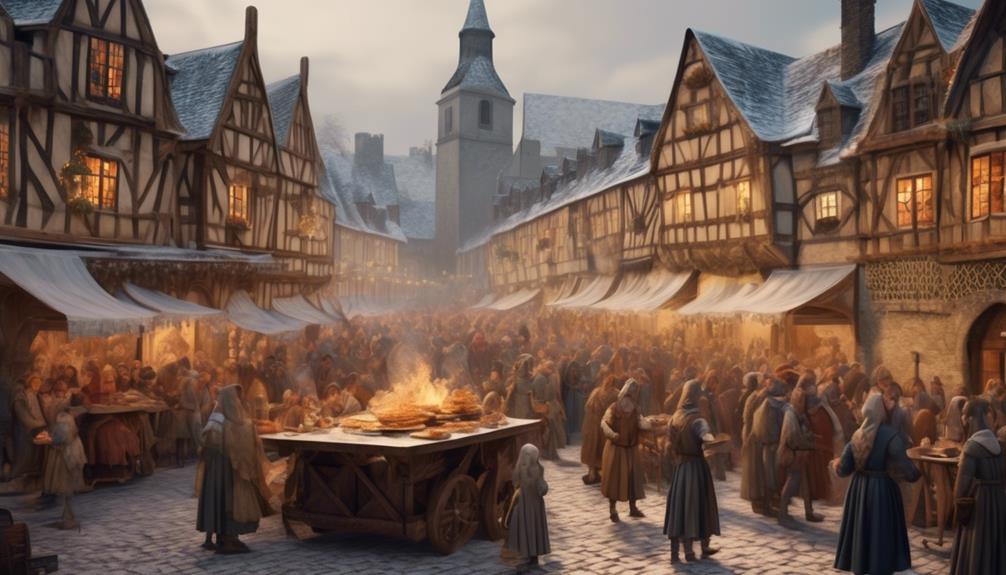
The tradition of celebrating Shrove Tuesday has deep historical roots, dating back to ancient Christian practices. Shrove Tuesday, also known as Pancake Day, has been observed for centuries as a day of feasting before the fasting period of Lent. The term 'shrove' is derived from the old English word 'shrive,' which means to confess one's sins and receive absolution. This day holds significance as a time for Christians to make Lenten preparations, including confessing their sins and seeking forgiveness before the solemn season of Lent begins.
Historically, Shrove Tuesday provided a way for communities to come together and use up rich, indulgent foods such as eggs, milk, and sugar, which were traditionally restricted during the Lenten fast. It was a time of communal gathering, where people would engage in acts of charity and service, helping those in need and strengthening the bonds of fellowship within their communities.
Understanding the history of Shrove Tuesday gives us insight into the origins of this tradition and emphasizes the importance of preparing oneself spiritually and serving others before the Lenten season.
Significance of Pancake Day
Indulging in a variety of rich, sweet, and savory treats, Pancake Day marks a festive occasion before the solemn period of Lent. The importance of Pancake Day lies in its cultural significance as a day of feasting and celebration before the start of Lent, a time of fasting and reflection for many Christians. This tradition of indulging in pancakes and other rich foods has been observed for centuries and holds a special place in the hearts of many communities.
To illustrate the cultural significance of Pancake Day, we can look at the festive treats enjoyed on this day. Below is a table showcasing some traditional pancake toppings enjoyed around the world:
| Country | Traditional Toppings |
|---|---|
| United Kingdom | Lemon and sugar |
| United States | Maple syrup and butter |
| Russia | Caviar and sour cream |
| France | Nutella and bananas |
The act of coming together to enjoy these indulgent dishes not only serves as a way to use up rich ingredients before Lent but also fosters a sense of community and togetherness. This communal aspect of Pancake Day emphasizes the importance of cherishing time with loved ones and serving others through shared meals.
Traditions of Shrove Tuesday
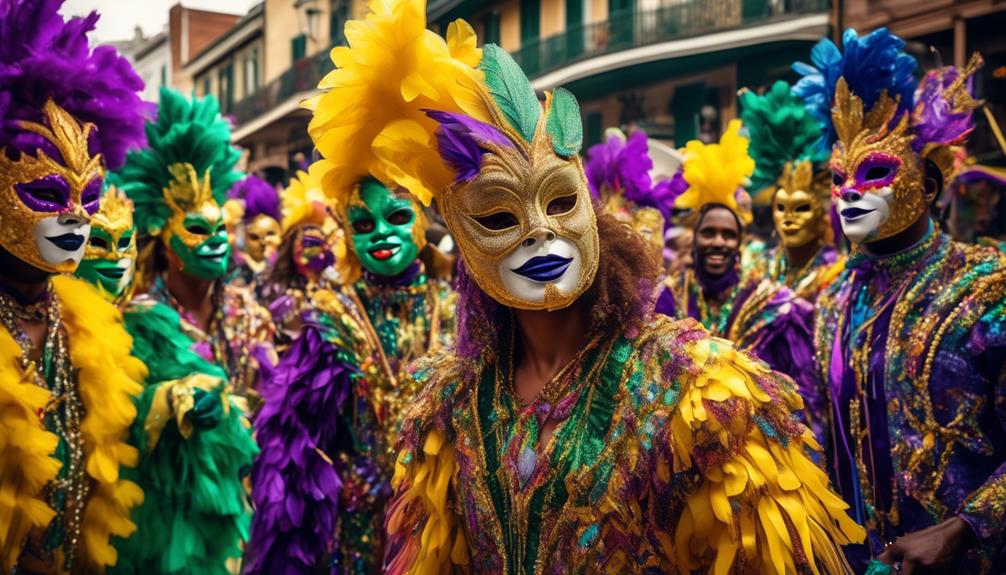
After enjoying a variety of rich and savory treats on Pancake Day, Shrove Tuesday traditions focus on the preparation for the upcoming period of Lent. Shrove Tuesday, also known as Fat Tuesday, holds deep cultural significance for many communities around the world. Here are some traditions observed on this day:
- Pancake Races: In the UK, a popular tradition involves participants racing while flipping pancakes in frying pans. This lighthearted event isn't only entertaining but also serves as a reminder of the need to use up rich ingredients before Lent.
- Feast and Charity: Many cultures celebrate Shrove Tuesday by indulging in a grand feast with family and friends. Additionally, there's a strong emphasis on acts of charity and service to others, reflecting the spirit of selflessness and giving that's central to the Lenten season.
These traditions not only add a sense of joy and festivity but also serve as a reminder of the importance of preparing oneself spiritually for the solemn period of Lent. Shrove Tuesday customs vary widely, but they all share the common themes of indulgence, selflessness, and preparation for the sacrifices ahead.
Pancake Day Around the World
Celebrating Pancake Day around the world involves a diverse array of culinary traditions and festive activities.
In the UK, it's common to toss pancakes in the air while they cook, symbolizing good luck for the coming year.
In France, 'La Chandeleur' sees people making crêpes, which are said to bring prosperity.
Similarly, in Russia, blinis are prepared and often accompanied by caviar and sour cream.
In Sweden, 'Fettisdagen' is celebrated with semla, a sweet bun filled with almond paste and whipped cream.
In the Netherlands, they enjoy poffertjes, small, fluffy pancakes served with powdered sugar and syrup.
Across cultures, the act of making and eating pancakes on this day signifies indulgence before the start of Lent. However, the specific pancake day traditions and cultural variations showcase the unique ways different countries embrace this tradition, reflecting the diversity and creativity found in culinary practices around the world.
Whether it's flipping pancakes, making crêpes, or savoring sweet buns, Pancake Day is a global celebration of delicious culinary traditions.
Shrove Tuesday in Different Cultures
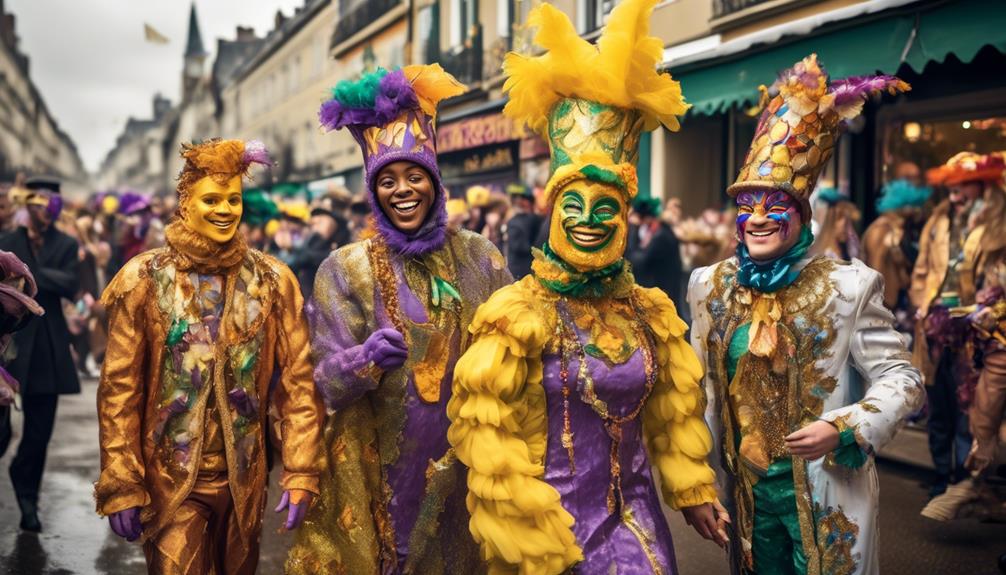
Across various cultures, the observance of Shrove Tuesday encompasses a variety of unique customs and culinary traditions. Shrove Tuesday, known as Mardi Gras in French-speaking countries, is celebrated with colorful parades, masquerade balls, and lively street parties in places like New Orleans, Rio de Janeiro, and Venice.
In the United Kingdom, the town of Olney holds a pancake race dating back to 1445, where participants race while flipping pancakes in a frying pan. Similarly, in Newfoundland, Canada, the tradition of 'tilting' involves balancing pancakes on a fork and racing through an obstacle course without dropping them.
In some Caribbean countries, Shrove Tuesday includes the tradition of 'J'ouvert,' a pre-dawn street party where revelers cover themselves in paint, mud, or oil.
In Sweden, the celebration of Fettisdagen involves indulging in semla, a sweet bun filled with almond paste and whipped cream, marking the last day before Lent.
Shrove Tuesday's cultural practices vary widely, reflecting the diversity of global traditions. These unique customs and culinary delights add vibrancy and joy to the observance of Shrove Tuesday across the world.
Activities on Pancake Day
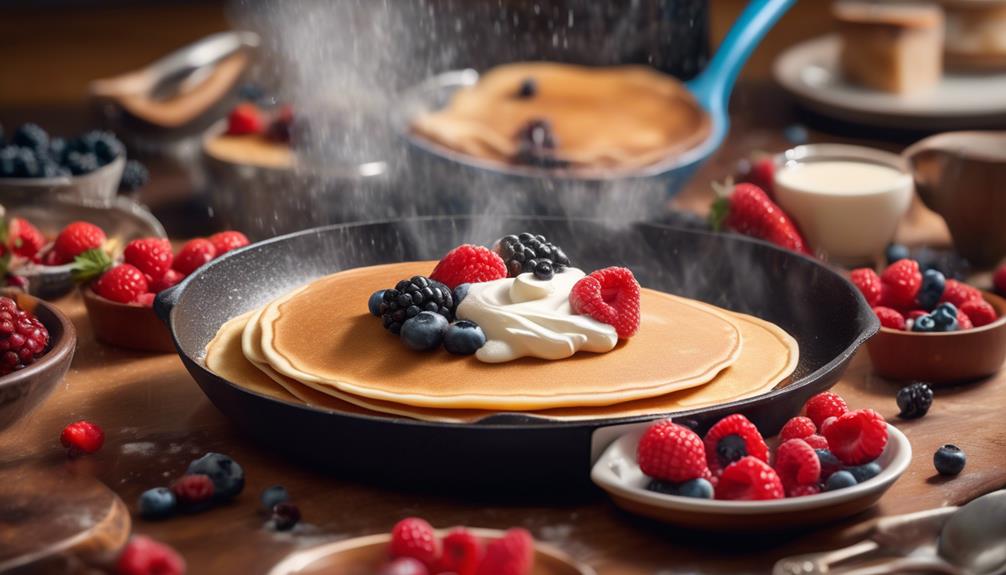
Pancake Day activities typically include flipping pancakes, hosting pancake races, and indulging in various pancake toppings and fillings. Pancake flipping is a fun and interactive activity where community members gather to showcase their pancake flipping skills. It's a great way to involve people of all ages in the festivities, bringing everyone together in a lighthearted and enjoyable manner.
Community gatherings on Pancake Day often feature pancake races, adding an element of friendly competition to the celebrations. These races can range from simple sprints to more elaborate relay races, with participants carrying a frying pan and flipping a pancake as they navigate the course. It's a delightful sight that brings laughter and cheer to the community, fostering a sense of togetherness and shared enjoyment.
Moreover, Pancake Day provides the perfect opportunity for serving others, whether it's through hosting pancake breakfasts for friends and neighbors or volunteering at local events. The act of preparing and sharing pancakes with others embodies the spirit of generosity and hospitality, creating meaningful connections within the community.
Religious Observance on Shrove Tuesday

As we shift our focus from the joyous community activities of Pancake Day, we recognize the religious observance that marks Shrove Tuesday. On this day, we reflect on the religious significance and cultural practices that have been observed for centuries.
Shrove Tuesday holds great importance in the Christian calendar, serving as the final day before the start of Lent, a period of fasting and penitence leading up to Easter. Here are some key insights into the religious observance on Shrove Tuesday:
- Pancake Tradition: Many communities engage in the tradition of making and consuming pancakes on this day, using up rich ingredients such as eggs, milk, and sugar before the Lenten fast begins.
- *Service Opportunities*: Churches often organize pancake breakfasts or events to bring the community together and raise funds for charitable causes, providing an opportunity for individuals to serve others through volunteer work.
- Confession and Absolution: In some Christian denominations, Shrove Tuesday is a time for confession and absolution, where individuals seek forgiveness and reconcile with God before the solemn period of Lent commences. This practice emphasizes the importance of spiritual introspection and the desire to serve by seeking forgiveness and reconciliation.
Food Associated With Pancake Day

Traditionally, my family and I celebrate Pancake Day by indulging in a delectable feast of various toppings and fillings for our homemade pancakes. Pancake recipes are a treasured part of our tradition, and we take pleasure in preparing a variety of pancake styles, from fluffy American pancakes to thin and crispy crepes.
Our pancake toppings range from classic choices like fresh fruits, whipped cream, and maple syrup to more indulgent options such as chocolate spread, caramelized nuts, and even savory ingredients like cheese and ham. We believe in offering a wide array of toppings to cater to the diverse tastes of our guests.
Additionally, we also make sure to include healthier options like yogurt, honey, and mixed berries for those who prefer lighter alternatives. The joy of Pancake Day for us comes from not only savoring these delectable treats ourselves but also from ensuring that everyone partaking in the celebration feels delighted and satisfied with the delightful pancake toppings we provide.
Traditional Shrove Tuesday Dishes

Indulging in a delectable feast of various traditional dishes, we embrace the flavors and customs of Shrove Tuesday beyond our beloved pancake recipes. This day holds cultural significance, and partaking in these traditional recipes symbolizes a time of preparation and reflection before the Lenten season.
Here are some delightful traditional Shrove Tuesday dishes that are cherished for their rich flavors and historical significance:
- Pancakes: While commonly associated with Pancake Day, these are an essential part of the Shrove Tuesday menu. The act of using up rich ingredients like eggs, milk, and sugar before Lent was a way to avoid waste and indulge before the fasting period.
- *Pancake Toppings*: From the classic lemon and sugar to more indulgent toppings like chocolate spread or fresh fruit, the variety of toppings adds a delightful touch to this traditional dish.
- Doughnuts: These deep-fried treats, often filled with jam or custard, have been a part of Shrove Tuesday celebrations for centuries. Their round shape symbolizes the coming together of the community.
These traditional dishes are more than just food; they're a way to honor the customs and values passed down through generations.
Modern Celebrations of Pancake Day

Modern celebrations of Pancake Day reflect a fusion of traditional customs with contemporary twists, encompassing a wide array of creative pancake recipes and communal gatherings.
In modern times, Pancake Day has evolved into a celebration that brings communities together through the joy of food and companionship. Pancake races have become a popular tradition, where participants race while flipping pancakes in a pan, adding an element of fun and lighthearted competition to the festivities.
Additionally, many communities organize pancake breakfasts or brunches, where people come together to enjoy a delicious meal and socialize with one another.
The celebration also embraces a diverse range of pancake recipes, allowing for inventive and unique culinary experiences. From classic buttermilk pancakes to more exotic variations like matcha or red velvet pancakes, there are endless options to cater to different tastes and preferences.
Moreover, communities often use Pancake Day as an opportunity to raise funds for charitable causes by hosting pancake-themed events or selling pancakes to raise money for local charities.
Contemporary Observance of Shrove Tuesday
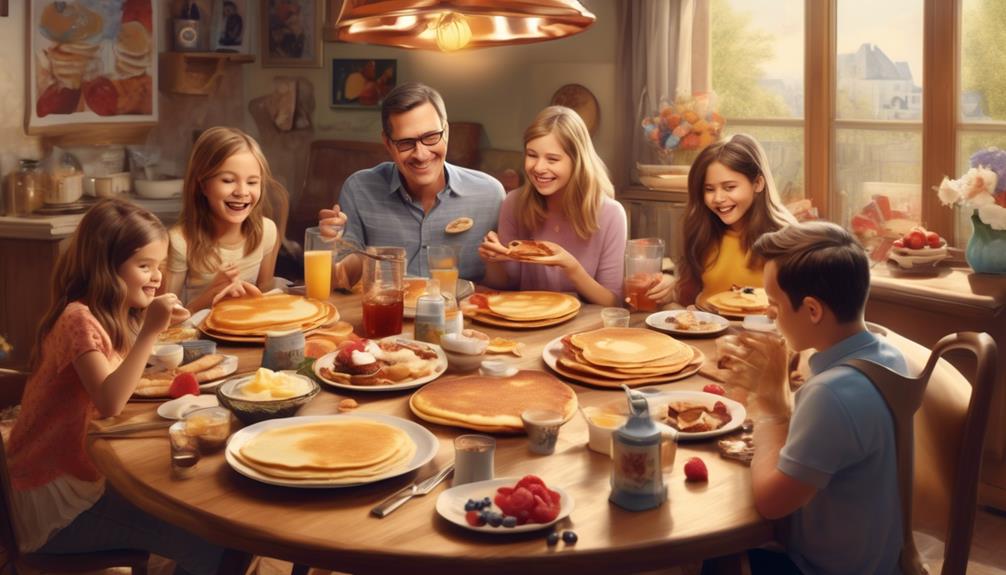
In contemporary times, many communities observe Shrove Tuesday with a variety of culinary and charitable events, reflecting a blend of traditional practices with modern twists.
- Culinary Delights:
- *Pancake Races*: In many towns and villages, locals participate in lighthearted pancake races, adding a fun and competitive element to the day's festivities.
- *Gourmet Pancake Creations*: Restaurants and cafes often offer special pancake menus, featuring innovative toppings and flavor combinations, catering to the evolving tastes of contemporary consumers.
- Charitable Giving:
- *Food Drives*: Recognizing the cultural significance of Shrove Tuesday's focus on indulgence before the Lenten season, many communities organize food drives or charity events to support those in need.
- *Community Feasts*: Churches and community centers host pancake suppers, not only as a way to bring people together but also to raise funds for various charitable causes, highlighting the spirit of giving during this time.
These contemporary traditions not only honor the historical significance of Shrove Tuesday but also adapt to the changing needs and interests of modern society, emphasizing the values of community, generosity, and service to others.
Conclusion and Reflection
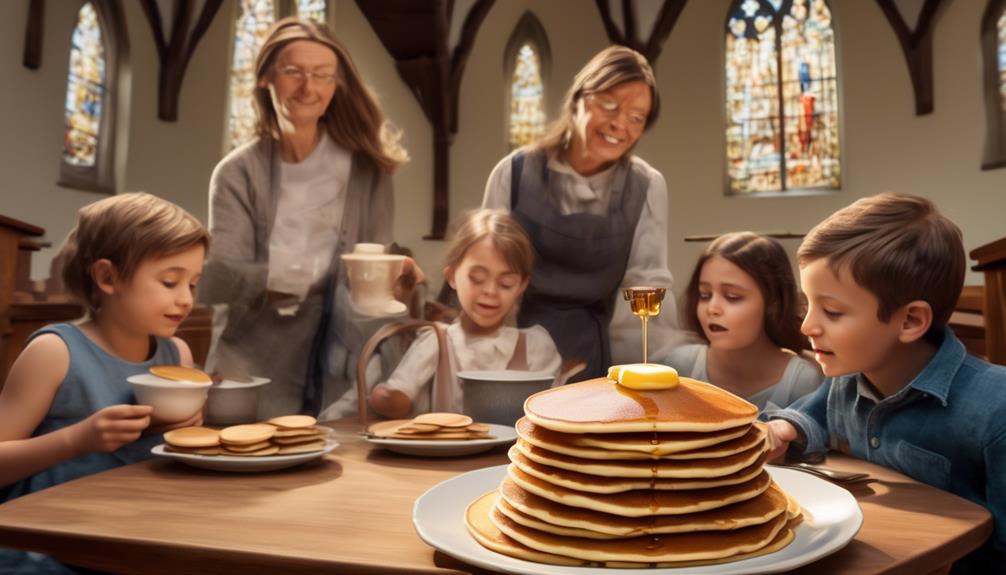
As we consider the contemporary observance of Shrove Tuesday and its culinary and charitable events, it's important to reflect on the enduring significance of these traditions and their relevance in today's society.
Shrove Tuesday, with its roots in religious observance, has evolved into a day of community and service. The act of making and sharing pancakes not only honors a centuries-old tradition but also provides an opportunity to come together and support those in need. Reflecting on these traditions reminds us of the cultural significance of communal gatherings centered around acts of kindness and generosity.
In today's fast-paced world, the value of traditions like Shrove Tuesday lies in their ability to foster a spirit of togetherness and giving. The act of indulging in pancakes and engaging in charitable activities not only connects us to our cultural heritage but also serves as a reminder of the importance of serving others.
As we reflect on these traditions, we're reminded of the enduring relevance of coming together to support and uplift one another, making Shrove Tuesday more than just a day for indulging in delicious treats, but a celebration of compassion and community.
Frequently Asked Questions
How Did Pancake Day and Shrove Tuesday Become Associated With Eating Pancakes?
We associate Pancake Day and Shrove Tuesday with eating pancakes due to the tradition of using up rich ingredients like eggs and milk before the fasting period of Lent.
The origin of pancakes dates back to ancient times, and various pancake recipes have evolved over the years.
Serving others by making and sharing pancakes embodies the spirit of community and generosity.
It's a delightful way to celebrate before the solemnity of Lent begins.
Are There Any Specific Rituals or Customs Related to Pancake Day and Shrove Tuesday That Are Not Widely Known?
Preparing for Lent, we engage in pancake flipping and lesser-known customs on Shrove Tuesday. These rituals, often overshadowed by the joy of indulging in pancakes, hold deep significance.
As we serve others, we embrace the spirit of selflessness and reflection, preparing our hearts for the Lenten journey.
Embracing these customs fosters a sense of community and compassion, enriching the spiritual significance of this day beyond its delicious culinary traditions.
What Are Some Unique Ways That Different Cultures and Countries Celebrate Pancake Day and Shrove Tuesday?
We've discovered some fascinating international variations in the way Pancake Day and Shrove Tuesday are celebrated. From the diverse pancake recipes to the cultural traditions, there are unique celebrations all around the world.
In France, they indulge in crêpes, while in Sweden, they savor semla buns. Each country has its own delightful twist on this tradition, making it a truly global celebration of delicious food and cultural diversity.
Are There Any Lesser-Known Religious or Historical Connections to Pancake Day and Shrove Tuesday?
We've uncovered fascinating religious connections and historical significance tied to Pancake Day and Shrove Tuesday. These lesser-known aspects reveal the deep roots of these traditions and their impact on diverse cultures.
The historical background paints a rich tapestry of customs and beliefs, shedding new light on the significance of these celebrations. It's truly amazing how these events weave together various threads of history and faith, creating a tapestry of cultural significance.
What Are Some Modern Twists on Traditional Pancake Day and Shrove Tuesday Celebrations That People Are Adopting?
Pancake alternatives and creative toppings have become popular twists on traditional Pancake Day and Shrove Tuesday celebrations. People are hosting virtual pancake parties and showcasing their pancake art skills.
At these events, we're incorporating unique ingredients like matcha, chai spices, or even savory options like bacon and cheese. These modern twists add a fun and inclusive element to the festivities, showcasing creativity and serving others in new and exciting ways.
Conclusion
In conclusion, Pancake Day and Shrove Tuesday may seem as different as night and day, but they both hold a special place in many cultures around the world.
Like two siblings with unique personalities, they bring joy and delight in their own ways. Whether it's flipping pancakes or indulging in rich foods before Lent, these traditions bring people together in celebration and reflection.
Each one is like a different flavor of the same delicious treat – sweet and satisfying.
- About the Author
- Latest Posts
Introducing Ron, the home decor aficionado at ByRetreat, whose passion for creating beautiful and inviting spaces is at the heart of his work. With his deep knowledge of home decor and his innate sense of style, Ron brings a wealth of expertise and a keen eye for detail to the ByRetreat team.
Ron’s love for home decor goes beyond aesthetics; he understands that our surroundings play a significant role in our overall well-being and productivity. With this in mind, Ron is dedicated to transforming remote workspaces into havens of comfort, functionality, and beauty.
Mardi Gras Decoration
Mardi Gras Decor Ideas: Bringing New Orleans Flair to Your Home
Get inspired with vibrant Mardi Gras decor ideas to transform your home into a festive New Orleans celebration that your guests won’t forget!
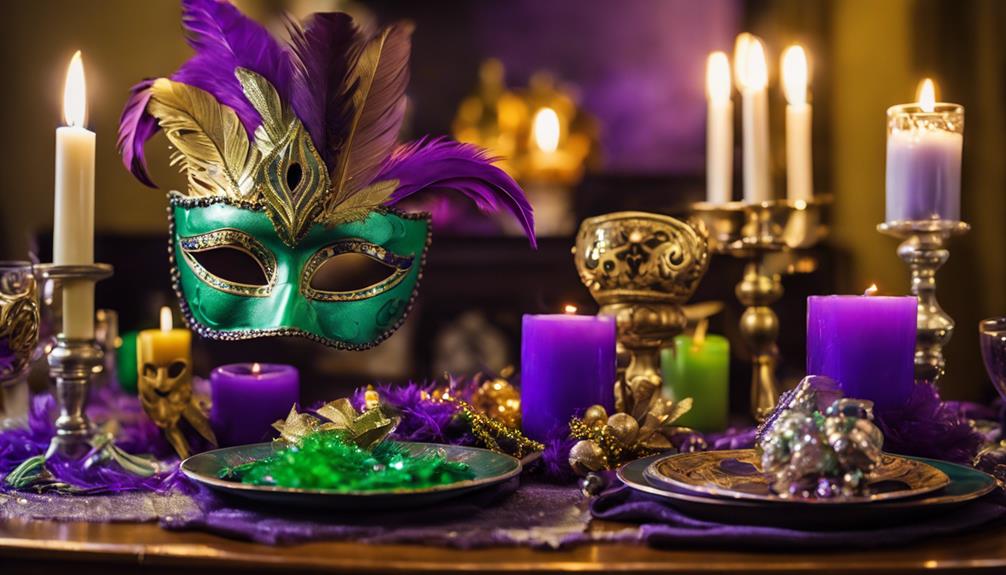
To bring the vibrant flair of New Orleans Mardi Gras into your home, embrace bold colors like purple, green, and gold. Add festive elements like masks, beads, and king cake to create an authentic atmosphere. Use a crisp white tablecloth to highlight colorful dishes and DIY decorations, like painted glassware or custom banners. Engage your guests with a themed coffee bar and vibrant centerpieces. Don't forget to design your space for conversation and fun. With these ideas, your Mardi Gras celebration will be unforgettable. Explore more creative tips to enhance your festive ambiance further!
Key Takeaways
- Embrace bold colors like purple, green, and gold to capture the essence of Mardi Gras and create a festive atmosphere.
- Incorporate traditional elements such as masks, beads, and king cake to enhance authenticity and celebrate New Orleans culture.
- Use a crisp white tablecloth as a backdrop to make vibrant decorations pop for an eye-catching table setting.
- Engage in DIY projects, like painting glassware and creating bead curtains, to add a personal touch to your decor.
Celebrate With Bold Colors
To truly celebrate Mardi Gras, you should embrace bold colors like purple, green, and gold, which capture the essence of this vibrant festival.
These bright colors not only symbolize justice, faith, and power, but they also bring an energetic flair to your home. Start with simple decorating ideas that incorporate these hues in your interior design. You might love to see table settings adorned with vibrant napkins and centerpieces that reflect the spirit of Mardi Gras.
Consider DIY projects that are budget friendly, like painting glassware in these festive colors or creating custom banners.
Adding colorful masks and beads as decorative accents can also enhance the festive theme, evoking the excitement of Mardi Gras parades right in your living space.
Don't overlook the power of floral arrangements; choose seasonal blooms in bold hues to serve as focal points in your home.
With these decorating ideas, you'll create a lively atmosphere that truly celebrates the spirit of Mardi Gras, inviting friends and family to join in the fun.
Essential Mardi Gras Elements

What essential elements should you include to create an authentic Mardi Gras celebration?
Start with a crisp white tablecloth as your base to enhance the vibrant colors of your decor. Incorporate classic Mardi Gras elements like king cake, masks, and beads, which capture the spirit of this festive occasion. Use simple white dishes for versatility and consider personalizing them with DIY plate decorations using glass paint markers.
To elevate your dining experience, add vintage candleholders and colorful drip candles, creating a warm and inviting ambiance. Gold napkins paired with Mardi Gras beads as decorative napkin rings will bring a touch of elegance to your table setting.
Don't forget about the festive beverages! Serve kids Abita Root Beer while adults can enjoy traditional offerings like Café Du Monde coffee and beignets.
These essential components won't only enhance the overall look of your Mardi Gras celebration but also immerse your guests in the rich cultural heritage of New Orleans. By including these elements, you'll create a lively atmosphere that captures the joy and excitement of Mardi Gras.
DIY Decor Projects

Enhancing your Mardi Gras celebration can be as simple as incorporating fun DIY decor projects that reflect the festive spirit of the occasion. These projects not only add a vibrant touch to your home but also create a warm and inviting atmosphere for your guests.
Here are some easy DIY decor ideas to get you started:
- Festive Bead Curtains: Create a curtain using strands of beads from Dollar Tree for just $3. This eye-catching display works great for entryways or windows.
- Themed Coffee Bar Sign: Paint a six-inch canvas with fun designs and add voodoo doll stitches for a unique sign that brings a playful touch to your coffee bar.
Tips for Hosting Parties
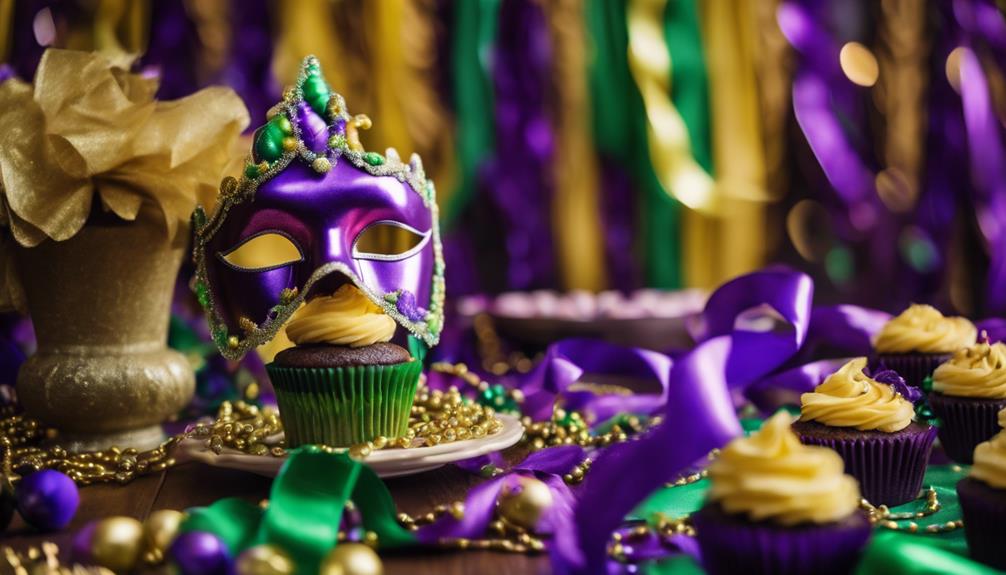
Hosting a memorable Mardi Gras party starts with a thoughtful layout that encourages conversation and keeps guests engaged. Assess your space and arrange furniture to create a welcoming atmosphere. Consider how guests will flow through the area, ensuring accessibility while mingling.
Use bold colors and festive decorations, like masks and beads, to enhance the celebratory spirit of your gathering. Think about incorporating multifunctional spaces—set up areas for dining, socializing, and entertainment. This allows guests to enjoy varied activities throughout the party.
To achieve cohesive decor, utilize themed elements such as a king cake centerpiece and vintage candleholders adorned with colorful candles. These details tie the room together and create a festive vibe.
As you're hosting parties, take note of how guests interact with your space. This can reveal areas for improvement, helping you make adjustments for future gatherings.
Incorporating Personal Style

Personalizing your Mardi Gras decor not only reflects your unique style but also makes your celebration feel more intimate and special. By showcasing unique treasures, like heirlooms and colorful pieces, you can weave your history into the festivities. Embrace bold colors—purple, green, and gold—to create lively spaces that resonate with your love for the holiday.
Here are some ideas to incorporate your personal taste:
- Use simple white dishes as a versatile base, allowing you to customize with themed elements like masks and beads.
- Engage in DIY projects such as painting personalized plates or crafting themed signs to add character and authenticity to your decor.
Frequently Asked Questions
When Should I Start Decorating for Mardi Gras?
You should start decorating for Mardi Gras at least a week before the event. This way, you'll have plenty of time to gather supplies and create vibrant displays that capture the festive spirit.
How Do You Have a Mardi Gras Party at Home?
To host a Mardi Gras party at home, you'll need vibrant colors, festive foods, lively music, and engaging activities. Set the scene, serve traditional dishes, and encourage creativity to create an unforgettable celebration.
How Do You Decorate for Mardi Gras?
To decorate for Mardi Gras, use vibrant colors like purple, green, and gold. Incorporate masks, beads, and themed vignettes. Consider DIY projects to personalize your space, adding vintage candleholders for an elegant, festive touch.
Conclusion
As you deck your home in vibrant purples, greens, and golds, it's funny how a celebration rooted in joy can remind you of life's chaos.
You might think you're just hanging beads and masks, but in reality, you're weaving a tapestry of memories, laughter, and community.
So, whether you're hosting a grand party or enjoying a quiet moment, remember: it's the spirit of Mardi Gras that transforms your space, turning your home into a joyous escape.
- About the Author
- Latest Posts
Introducing Ron, the home decor aficionado at ByRetreat, whose passion for creating beautiful and inviting spaces is at the heart of his work. With his deep knowledge of home decor and his innate sense of style, Ron brings a wealth of expertise and a keen eye for detail to the ByRetreat team.
Ron’s love for home decor goes beyond aesthetics; he understands that our surroundings play a significant role in our overall well-being and productivity. With this in mind, Ron is dedicated to transforming remote workspaces into havens of comfort, functionality, and beauty.
Mardi Gras Decoration
Why Is Mardi Gras a Religious Holiday

Some people may argue that Mardi Gras is just a festival of partying and extravagance, completely disconnected from any religious meaning. Nevertheless, when delving into the historical origins and cultural customs of this yearly event, it becomes clear that Mardi Gras has strong ties to religious symbolism and practices.
From its origins as a Christian feast day to its connections with the Lenten season and spiritual practices, Mardi Gras holds a significant religious significance. But how exactly did this festive event become associated with religious observances?
Stay tuned as we uncover the religious underpinnings of Mardi Gras and its relevance in modern-day celebrations.
Key Takeaways
- Mardi Gras has pagan roots and was incorporated into the Christian liturgical calendar.
- The colors of Mardi Gras (purple, green, and gold) have Christian symbolism.
- Mardi Gras marks the beginning of the Christian liturgical season of fasting and reflection.
- Masks, throws, and king cakes all have religious symbolism in Mardi Gras celebrations.
Origins of Mardi Gras
The origins of Mardi Gras date back to ancient pagan celebrations and were later incorporated into Christian traditions. Mardi Gras, French for 'Fat Tuesday,' has deep pagan roots, originally linked to Roman and Greek festivals celebrating the arrival of spring and fertility. These pagan festivities were eventually adapted by the Christian church as a way to incorporate and reframe these cultural celebrations within the context of Christian beliefs.
Over time, the carnival-like atmosphere and traditions of Mardi Gras became intertwined with the Christian liturgical calendar, specifically the period of feasting and celebration before the solemnity of Lent.
The cultural significance of Mardi Gras lies in its ability to bring people together in joyous celebration before the introspective and penitent season of Lent. It has become a time for communities to come together, feast, and revel in the richness of life before a period of sacrifice and reflection. This celebration reflects the deep human need for both communal joy and personal growth, making Mardi Gras a holiday with profound spiritual and cultural significance.
Christian Traditions and Symbolism

Christian traditions and symbolism play a significant role in the evolution and observance of Mardi Gras. The colors of Mardi Gras, purple, green, and gold, are steeped in Christian symbolism. Purple symbolizes justice, green represents faith, and gold signifies power. These colors reflect the religious significance of Mardi Gras, reminding us of our Christian values and calling us to live out these virtues.
The practice of consuming rich and indulgent foods before the fasting period of Lent also holds religious connotations. This tradition, known as 'Fat Tuesday,' encourages us to reflect on the upcoming period of self-discipline and spiritual growth. It serves as a reminder of Christ's sacrifice and the importance of repentance and inner renewal.
Furthermore, Mardi Gras is deeply tied to Christian traditions through its association with the liturgical calendar. The observance of Ash Wednesday, which marks the beginning of Lent, is intrinsically linked to the revelry of Mardi Gras. This juxtaposition of celebration and solemnity underscores the profound religious significance of Mardi Gras within the Christian faith.
Relationship With the Lenten Season
As believers, we closely connect Mardi Gras with the upcoming Lenten season, a period of reflection and spiritual growth. Mardi Gras, also known as Fat Tuesday, falls just before Ash Wednesday, which marks the beginning of Lent. This connection is deeply rooted in Catholic tradition, where Mardi Gras serves as a final celebration before the solemn and reflective season of Lent. It's a time for us to prepare our hearts and minds for the Lenten journey ahead, where we focus on prayer, fasting, and almsgiving.
Lenten preparation starts with the joyous festivities of Mardi Gras, reminding us of the upcoming season's call to serve others with humility and compassion. As we engage in the revelry of Mardi Gras, we're also mindful of the need to embark on a period of self-examination and spiritual discipline during Lent. This dual experience reinforces the connection between the two, reminding us of the importance of balancing celebration with introspection and service.
Our relationship with the Lenten season isn't just about personal reflection but also about how we can better serve those around us. This connection between Mardi Gras and Lent deepens our understanding of the call to love and serve others, making the transition from celebration to spiritual growth seamless and purposeful.
Religious Observances and Practices

In our religious observances and practices, we engage in acts of devotion and service that deepen our spiritual connection and foster a sense of community. These practices are essential for nurturing our faith and strengthening our bond with each other.
Here are some key aspects of our religious observances and practices:
- Prayer Rituals
- We believe in the power of prayer to seek guidance, express gratitude, and offer intercession for others.
- Through regular prayer rituals, we cultivate a deeper connection with the divine and find solace in times of need.
- Service to Others
- Serving others is integral to our religious beliefs, and we actively seek opportunities to extend compassion and support to those in need.
- By engaging in acts of service, we emulate the values of our faith and contribute to the well-being of our community.
- Religious Festivals
- Religious festivals hold great significance in our spiritual journey, providing opportunities for communal worship, reflection, and celebration.
- These festivals offer a chance for us to come together as a community, reaffirm our shared beliefs, and find inspiration in the collective expression of faith.
Our religious observances and practices are a testament to our commitment to serving others and nurturing our spiritual connection through prayer rituals and participation in religious festivals.
Spiritual Significance in Modern Celebrations
Amidst the vibrant festivities of modern celebrations, we find a deep and enduring spiritual significance that unites us in shared reverence and reflection.
In today's Mardi Gras, the spiritual aspect has evolved to encompass a broader, more inclusive understanding. Modern interpretations of Mardi Gras emphasize the cultural significance of coming together as a community to celebrate life, joy, and resilience.
It's a time when people seek to uplift one another, embodying the values of compassion, kindness, and charity. This spiritual underpinning is evident in the various community service initiatives that have become integral to Mardi Gras celebrations.
From volunteering at local shelters to organizing food drives, there's a growing emphasis on using this festive occasion as an opportunity to serve and support those in need.
In this way, Mardi Gras has become not only a time of revelry but also a period of meaningful connection and service to others, reflecting the enduring spiritual significance that continues to shape modern celebrations.
Frequently Asked Questions
How Do Non-Christian Religions and Cultures Celebrate Mardi Gras?
We celebrate Mardi Gras with non-Christian celebrations and cultural influences. People of various faiths and backgrounds come together to participate in the festivities.
Non-Christian traditions such as parades, mask-wearing, and indulging in rich foods are integrated into the celebrations.
Cultural influences from different regions and ethnicities add vibrant and diverse elements to the Mardi Gras festivities, creating a unique and inclusive experience for everyone involved.
What Is the Role of Mardi Gras in the History of Religious Persecution and Tolerance?
Mardi Gras has a significant role in the history of religious tolerance and has been tied to historical persecution. The celebration represents a time of religious freedom and acceptance, where diverse cultures come together in unity.
The festivities reflect the resilience of communities in the face of religious adversity. Through the ages, Mardi Gras has stood as a symbol of religious tolerance and the triumph of the human spirit over oppression.
How Do Different Christian Denominations Interpret the Religious Significance of Mardi Gras?
Different Christian denominations interpret the religious significance of Mardi Gras differently. These interpretation differences stem from varying theological beliefs and historical traditions.
The religious significance celebrations can range from solemn reflections on the upcoming Lenten season to joyous celebrations of the last moments before the fasting period.
Understanding these differences allows us to appreciate the diverse ways in which different denominations honor this important religious holiday.
Are There Any Specific Prayers or Rituals Associated With Mardi Gras in Religious Observances?
Prayer traditions and ritual practices are integral to religious observances of Mardi Gras. Many denominations hold special prayer services and engage in symbolic rituals as part of their Mardi Gras celebrations. These can include praying for forgiveness, participating in processions, and observing fasting and abstinence.
These practices are intended to prepare for the solemn season of Lent and reflect on the spiritual significance of Mardi Gras.
How Have Modern Interpretations of Spirituality and Mindfulness Influenced the Way Mardi Gras Is Celebrated in Religious Communities?
Modern interpretations of spirituality and secular influence have shaped the way Mardi Gras is celebrated in religious communities.
Spiritual mindfulness has led to a greater emphasis on reflection and serving others during this cultural celebration.
In some religious observances, Mardi Gras has evolved to incorporate elements of community service and outreach, reflecting a deeper connection to the principles of faith and compassion in the modern context.
Conclusion
In conclusion, Mardi Gras is a religious holiday rooted in rich traditions and symbolism. Its origins and observances are deeply tied to the Christian faith, particularly in preparation for the Lenten season.
The spiritual significance of Mardi Gras is still evident in modern celebrations, showcasing the enduring connection between faith and festivity.
So let's remember the religious roots and revel in the spiritual significance of this colorful and vibrant holiday!
- About the Author
- Latest Posts
Introducing Ron, the home decor aficionado at ByRetreat, whose passion for creating beautiful and inviting spaces is at the heart of his work. With his deep knowledge of home decor and his innate sense of style, Ron brings a wealth of expertise and a keen eye for detail to the ByRetreat team.
Ron’s love for home decor goes beyond aesthetics; he understands that our surroundings play a significant role in our overall well-being and productivity. With this in mind, Ron is dedicated to transforming remote workspaces into havens of comfort, functionality, and beauty.
Mardi Gras Decoration
How to Make Mardi Gras Decorations
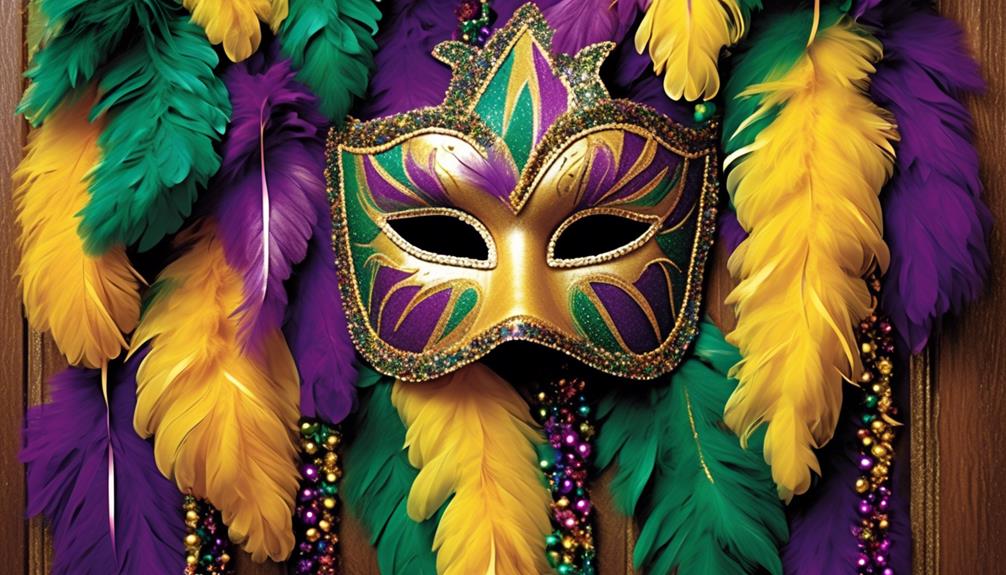
When it comes to decorating for Mardi Gras, we often struggle to find a balance between making a memorable impact and sticking to a budget. The key is to blend boldness and elegance, creating a festive atmosphere that embodies the essence of the holiday without being too overwhelming.
With a few simple yet creative ideas, you can transform any space into a festive Mardi Gras wonderland that will have everyone feeling the festive spirit.
Key Takeaways
- Mardi Gras decorations can include masks, jester hats, bead garlands, feather boas, and glittery table centerpieces.
- Masks can be painted with bold patterns and designs using acrylic paints and glitter.
- Jester hats can be created using colorful cardstock, glitter, bells, and elastic bands.
- Bead garlands can be used to decorate parade floats or create a festive atmosphere, and can also be used to create bead bracelets, necklaces, belts, and headpieces.
Colorful Mardi Gras Masks
Let's get ready to create vibrant and eye-catching Mardi Gras masks that will add a burst of color and excitement to our decorations. Mask painting is a delightful activity that allows us to express our creativity and add a personal touch to the festive ambiance.
To start, gather a variety of plain masks, acrylic paints, paintbrushes, glitter, feathers, and other embellishments. Begin by brainstorming designs and color schemes. Once you have a plan in mind, use the paint to create bold patterns, intricate designs, or even abstract art on the masks. Experiment with different brush strokes and techniques to achieve the desired effect.
Don't forget to let each layer of paint dry before adding new elements to avoid smudging or blending colors unintentionally. As the base design takes shape, explore mask decorating techniques such as adding glitter for a touch of sparkle or attaching feathers to create a dramatic effect.
These masks won't only enhance our decorations but also bring joy to those who see them. Let's share this creative experience with others and spread the vibrant spirit of Mardi Gras!
Festive Bead Garlands
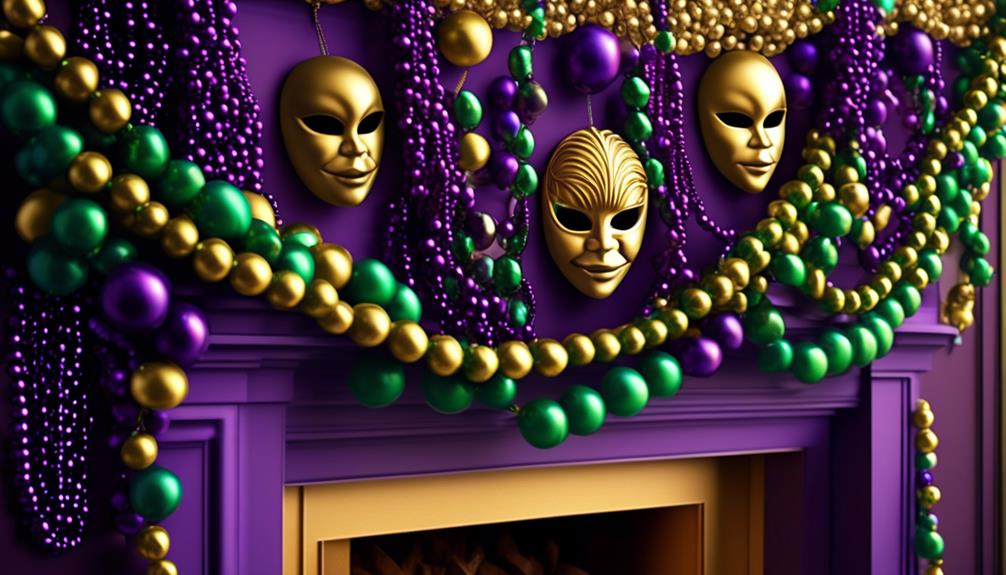
After creating our colorful Mardi Gras masks, we are now ready to dive into the world of festive bead garlands, adding a touch of elegance and flair to our decorations. Bead crafting techniques can elevate the ambiance of any Mardi Gras celebration. To assist you in this endeavor, we've compiled a selection of DIY costume accessories and parade float decorations that will surely delight your guests and spectators.
| Bead Crafting Techniques | Party Favor Ideas | DIY Costume Accessories | Parade Float Decorations |
|---|---|---|---|
| Stringing beads to create stunning garlands | Giving away homemade bead bracelets as party favors | Crafting bead necklaces, belts, and headpieces | Using bead garlands to adorn parade floats and create a festive atmosphere |
Vibrant Feather Boas
Let's talk about the vibrant feather boas!
When it comes to Mardi Gras decorations, feather boas are a must-have.
We'll explore the wide array of feather boa colors, embellishments, and creative hanging ideas to make your Mardi Gras celebration truly unforgettable.
Feather Boa Colors
What are the most vibrant colors available for feather boas to create eye-catching Mardi Gras decorations? When it comes to boa color trends, it's all about bold and lively hues that capture the festive spirit of Mardi Gras.
Here are some vibrant feather boa colors that will make your decorations stand out:
- Emerald Green: This rich and lush shade of green represents the traditional color of Mardi Gras and will instantly bring a touch of elegance to your decor.
- Royal Purple: A deep and regal purple adds a sense of grandeur to your Mardi Gras decorations, symbolizing justice and power.
- Golden Yellow: Bright and radiant, a golden yellow feather boa brings a vibrant burst of energy and joy to your festive arrangements.
These vibrant feather boa colors will elevate your Mardi Gras decorations and create a captivating visual experience for all.
Boa Embellishments
As we explore boa embellishments, we'll incorporate vibrant feather boas, such as emerald green, royal purple, and golden yellow, to infuse our Mardi Gras decorations with elegance and energy.
When creating a boa costume, these feather boas can be draped around hats, sewn onto dresses, or used as sashes for a fun and festive look.
For parade floats, consider using feather boas to adorn the edges, creating a lavish and eye-catching display. To make the most of these boas, intertwine different colors, layer them for a fuller effect, and mix and match textures for added visual appeal.
Additionally, feather boas can be used to create stunning table centerpieces or to embellish masks, adding a touch of glamour to your Mardi Gras celebration.
Boa Hanging Ideas
To create striking boa hanging decorations, select vibrant feather boas in rich colors such as emerald green, royal purple, and golden yellow to infuse your space with the lively spirit of Mardi Gras.
For an eye-catching boa display, consider these hanging arrangements:
- Boa Curtain: Drape long strands of feather boas across doorways or windows to create a dazzling curtain effect, welcoming guests with a festive flair.
- Boa Chandelier: Craft a stunning boa chandelier by suspending multiple boas from a wire frame or hoop, adding a touch of elegance and whimsy to your Mardi Gras festivities.
- Boa Garland: String together colorful feather boas to make a vibrant garland that can be hung along staircases, mantels, or tables, bringing a festive and playful atmosphere to any space.
These hanging arrangements will elevate your Mardi Gras decor and make your celebration truly unforgettable.
Glittery Table Centerpieces
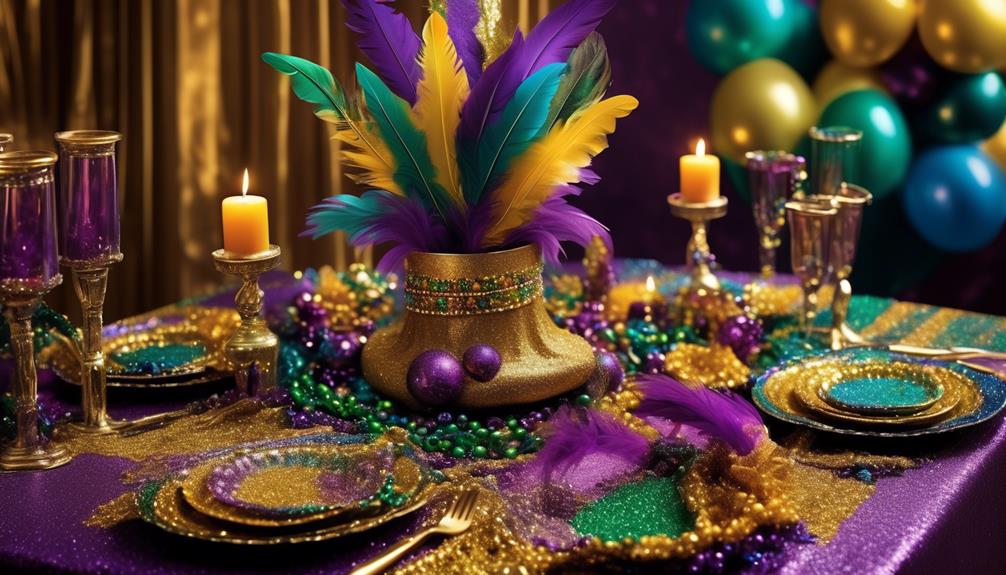
Let's talk about creating stunning glittery table centerpieces for your Mardi Gras celebration.
First, we'll cover the materials needed to bring these dazzling decorations to life.
Then, we'll provide step-by-step assembly instructions to ensure your centerpieces shine bright.
Materials Needed
We can create stunning glittery table centerpieces by gathering clear glass vases, glitter in various colors, mod podge, and paintbrushes for this craft project.
To make these beautiful centerpieces, we can use creative alternatives like recycled glass jars or repurposed wine bottles to serve as the vases. This not only adds a unique touch to the decorations but also provides budget-friendly options.
The glitter in various colors allows for personalization, and the mod podge acts as an adhesive and sealer, ensuring the glitter stays in place.
Paintbrushes are essential for applying the mod podge evenly and precisely onto the vases.
With these materials, we can bring a touch of sparkle and elegance to our Mardi Gras celebration.
Assembly Instructions
Using an assortment of clear glass vases, glitter in various colors, mod podge, and paintbrushes, we can proceed to assemble the glittery table centerpieces for our Mardi Gras celebration.
First, ensure the vases are clean and dry.
Next, apply a coat of mod podge to the outside of the vase using a paintbrush.
Then, sprinkle the glitter onto the mod podge, ensuring it covers the entire surface evenly. For a creative touch, consider mixing different colors of glitter or creating patterns.
Once the glitter is applied, let the vases dry completely.
To prevent the glitter from shedding, seal the glitter with another layer of mod podge.
Allow the vases to dry thoroughly before placing them on the tables.
These centerpieces will surely add a dazzling and festive touch to our Mardi Gras celebration.
Display and Enjoy
With our glittery table centerpieces assembled and dried, we can now showcase them as the sparkling focal point of our Mardi Gras celebration. Here's how to display and enjoy them:
- Place the glittery table centerpieces on the main dining table, ensuring they're evenly spaced to create a stunning visual impact.
- Surround the centerpieces with complementary party supplies such as colorful beads, masks, and feather boas to enhance the festive atmosphere.
- Encourage guests to snap photos with the beautiful DIY crafts and use them as conversation starters, adding an extra touch of charm to the celebration.
Homemade Jester Hats
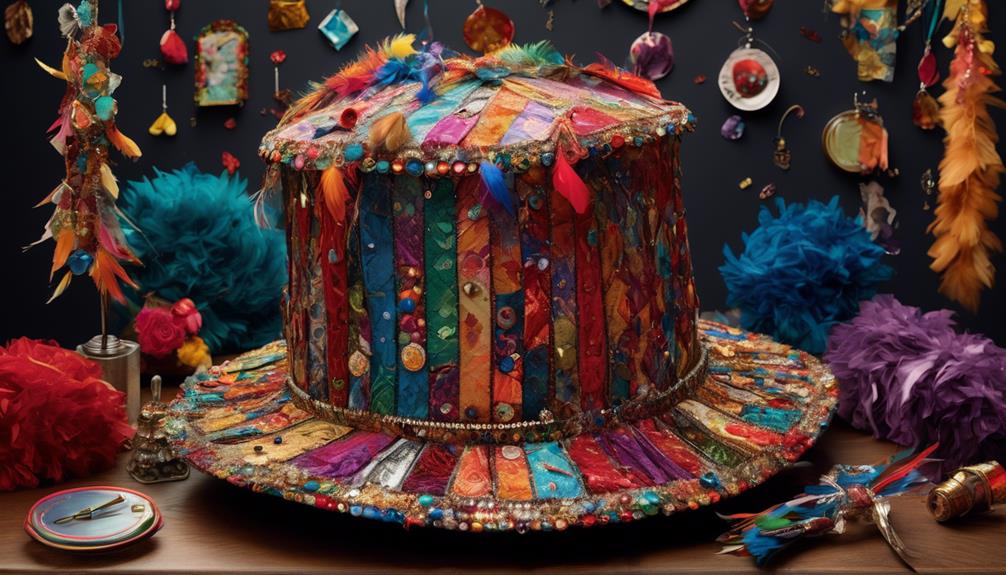
Crafting jester hats at home allows for personalized touches and creativity to shine through, adding a unique and festive flair to your Mardi Gras decorations.
Making DIY costume jester hats can be a fun and rewarding activity for both adults and kids. To start, gather supplies like colorful cardstock, glitter, bells, and elastic bands.
Cut the cardstock into long strips and staple or glue the ends together to form a band that fits around your head. Then, cut out diamond shapes from more cardstock and attach them to the band, alternating colors to create a vibrant, jester-style pattern.
Add glitter and bells for extra pizzazz. For the finishing touch, attach elastic bands to keep the hat in place.
These homemade jester hats can be great additions to your Mardi Gras party favors, and they also provide a delightful activity for guests to engage in during the celebration.
Sparkling Door Wreaths
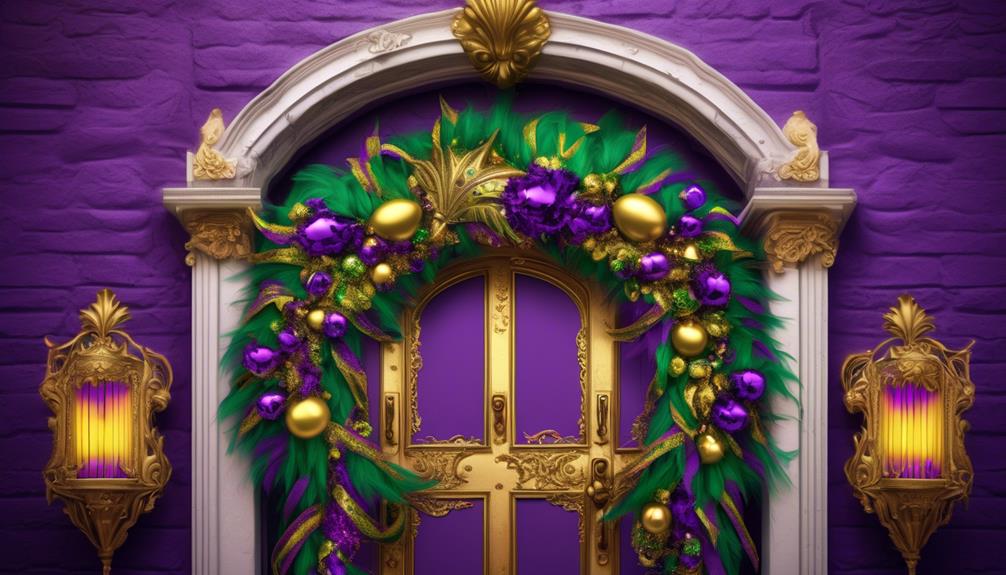
Let's create eye-catching sparkling door wreaths to add a touch of glamour and festivity to your Mardi Gras decor. Making a DIY wreath for Mardi Gras can be a fun and rewarding project. Here are some wreath decorating ideas to help you get started:
- Beaded Elegance: String colorful Mardi Gras beads around a foam or vine wreath base, securing them with hot glue. Add in some shimmering metallic beads for an extra touch of elegance.
- Feathery Flourish: Attach vibrant feathers in green, gold, and purple to the wreath using floral wire or hot glue. Layer the feathers for a lush and extravagant look.
- Glittering Accents: Sprinkle a foam or vine wreath with glitter in Mardi Gras colors. Secure the glitter with a clear sealant spray to prevent it from shedding. Then, add in some glittery Mardi Gras masks, fleur-de-lis ornaments, or decorative picks for a dazzling finish.
Creating your own sparkling door wreaths is a delightful way to showcase your creativity and bring the festive spirit of Mardi Gras to your home.
Masked Balloon Bouquets
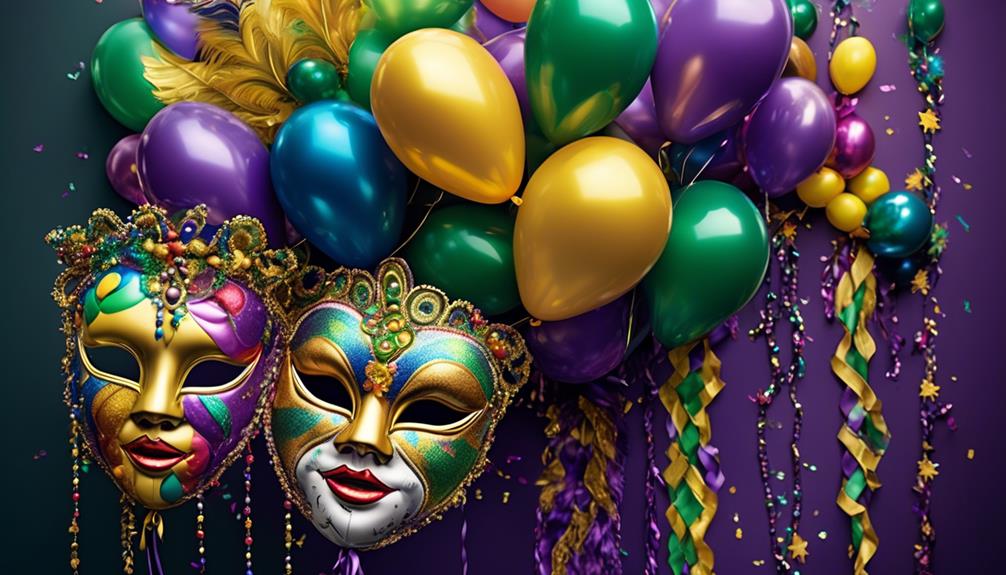
After adorning our doors with sparkling wreaths, we can enhance our Mardi Gras decor by creating vibrant and festive masked balloon bouquets. These balloon sculptures add a touch of whimsy and elegance to any masquerade party.
To craft these stunning bouquets, start by selecting an assortment of Mardi Gras colored balloons, such as purple, green, and gold. Use a variety of sizes to add visual interest. Next, inflate the balloons and tie them off, ensuring they're fully inflated for a beautiful effect.
Once you have your balloons ready, attach them to balloon sticks or lightweight wooden dowels. To create the masked effect, attach elegant masquerade masks to the top of each bouquet. Secure the masks by tying them to the sticks with colorful ribbons that complement the balloon colors. Consider adding glitter or sequins to the masks for an extra festive touch.
Arrange the finished balloon bouquets in strategic locations around your party space, such as near the entrance, the dance floor, or the food table. These vibrant and eye-catching decorations will surely delight your guests and elevate the festive atmosphere of your Mardi Gras celebration.
Jazz-Inspired Wall Decor

Exploring the rhythmic and colorful essence of jazz, we can infuse our Mardi Gras decor with captivating and vibrant wall art inspired by the soulful melodies and spirited energy of this musical genre. Jazz music, with its improvisational nature and rich history, provides a perfect backdrop for artistic inspiration as we create stunning wall decor for our Mardi Gras celebrations.
- Musical Notes Mural: Adorn your walls with a larger-than-life mural depicting swirling musical notes in vibrant Mardi Gras colors. Let the notes dance across the wall, capturing the vivacious spirit of jazz music and adding a dynamic focal point to your decor.
- Vintage Album Cover Display: Showcase vintage jazz album covers in stylish frames, creating a gallery wall that pays homage to the classic artistry of the genre. The striking visuals and evocative designs of these album covers will infuse your space with the timeless allure of jazz.
- DIY Jazz-Inspired Art: Get creative and make your own jazz-inspired art pieces using mixed media, incorporating elements like musical instruments, bold colors, and expressive brushstrokes. These unique creations will bring an authentic and personalized touch to your Mardi Gras wall decor, reflecting the improvisational and eclectic nature of jazz.
Frequently Asked Questions
Where Can I Find Affordable Mardi Gras Decorations?
We usually find affordable Mardi Gras decorations at online retailers and local stores. Online retailers offer a wide variety of Mardi Gras decorations at competitive prices, while local stores may have unique and affordable options.
For budget-friendly options, we often opt for DIY decorations. When seeking budget-friendly options, DIY decorations can be a fun and cost-effective way to add a personal touch to your Mardi Gras decor.
Are There Any Traditional Mardi Gras Symbols That I Should Include in My Decorations?
Traditional symbols like fleur-de-lis, masks, and beads are essential for DIY Mardi Gras decorations. Incorporating these symbols can add an authentic touch to your decor. Look for affordable options at craft stores or online to stay within budget.
Get creative with colors and patterns to make your decorations stand out. These symbols will bring the festive Mardi Gras spirit into your home without breaking the bank.
How Can I Incorporate Mardi Gras Decorations Into My Outdoor Space?
We can incorporate Mardi Gras decorations into our outdoor space by creating DIY Mardi Gras themed crafts. Hanging colorful banners, making festive wreaths, and crafting unique yard signs are great ways to bring the Mardi Gras spirit outside.
We can also use traditional Mardi Gras symbols like fleur-de-lis and masks to add authenticity to our outdoor decor.
What Are Some Creative Ways to Display Mardi Gras Decorations in My Home?
We've found that a creative centerpiece is a great way to showcase Mardi Gras decorations in your home.
You can make a DIY garland using colorful beads, feathers, and masks to really bring the festive spirit to any room.
Can I Make My Own Mardi Gras Decorations Using Items I Already Have at Home?
Absolutely, we can create our own Mardi Gras decorations using household items. DIY decorations aren't only budget-friendly, but they also add a personal touch to our celebrations.
By repurposing items like colorful fabric, beads, and paper, we can craft vibrant and festive décor. From handmade masks to garlands, the possibilities are endless.
Let's get creative and infuse our homes with homemade Mardi Gras spirit!
Conclusion
So, let's get ready to jazz up our Mardi Gras celebrations with these fabulous decorations!
With colorful masks, festive garlands, vibrant feather boas, glittery centerpieces, homemade jester hats, sparkling wreaths, masked balloon bouquets, and jazz-inspired wall decor, our party is sure to be a sight to behold.
Let's bring the spirit of Mardi Gras to life with these dazzling and lively decorations that will transform any space into a festive and vibrant celebration!
- About the Author
- Latest Posts
Introducing Ron, the home decor aficionado at ByRetreat, whose passion for creating beautiful and inviting spaces is at the heart of his work. With his deep knowledge of home decor and his innate sense of style, Ron brings a wealth of expertise and a keen eye for detail to the ByRetreat team.
Ron’s love for home decor goes beyond aesthetics; he understands that our surroundings play a significant role in our overall well-being and productivity. With this in mind, Ron is dedicated to transforming remote workspaces into havens of comfort, functionality, and beauty.
-

 Vetted5 days ago
Vetted5 days ago15 Best Boxwood Varieties for Thriving in Full Sunlight
-

 Vetted1 week ago
Vetted1 week ago15 Best Ways to Label Clothes for Nursing Home Residents – Stay Organized and Efficient
-

 Vetted6 days ago
Vetted6 days ago15 Best Dryer Vent Hoses to Keep Your Laundry Room Safe and Efficient
-

 Vetted6 days ago
Vetted6 days ago15 Best Spider Sprays to Keep Your Home Arachnid-Free
-

 Vetted5 days ago
Vetted5 days ago14 Best Cleaners for Aluminum Surfaces – Shine Bright Like a Diamond
-

 Vetted6 days ago
Vetted6 days ago15 Best Nightstand Charging Stations to Keep Your Devices Organized and Ready to Go
-

 Vetted17 hours ago
Vetted17 hours ago15 Best Ways to Waterproof Wood for Ultimate Protection and Longevity
-

 Beginners Guides4 days ago
Beginners Guides4 days agoHow to Slow Down My Ceiling Fan to Reduce Wind Chill


























